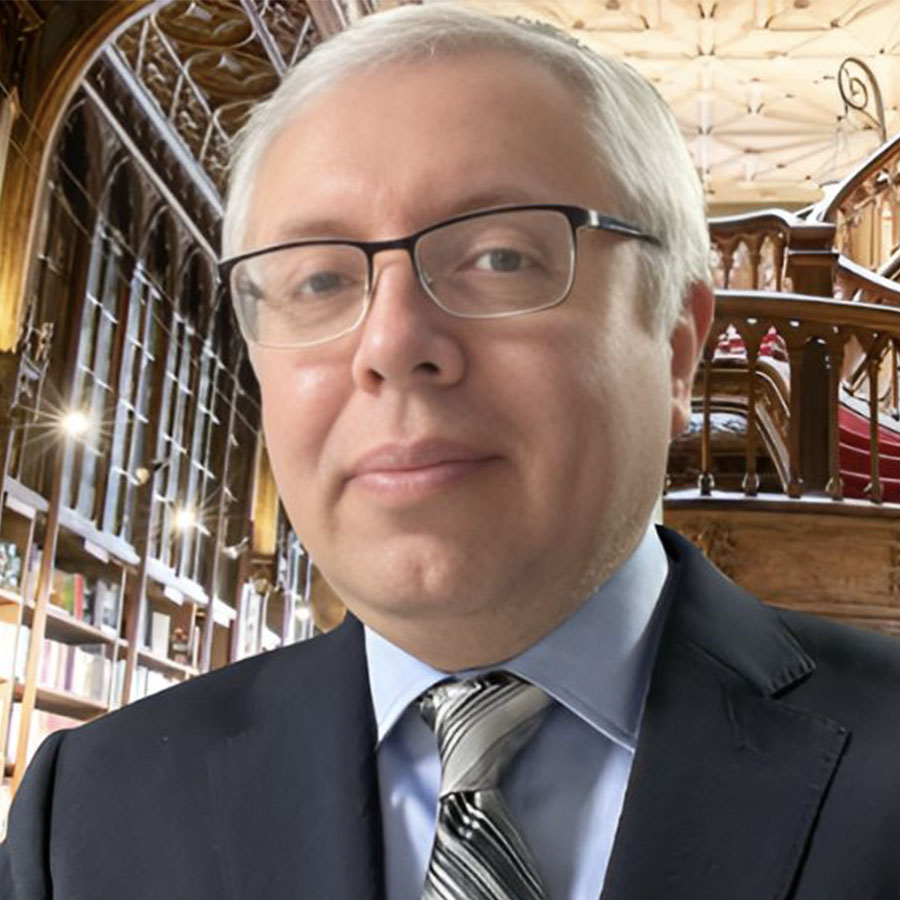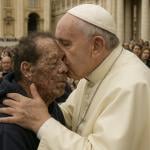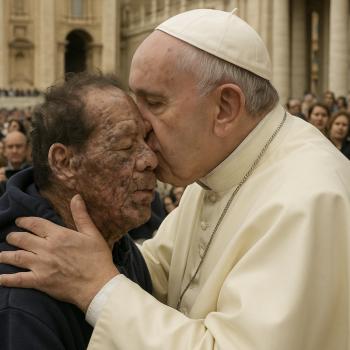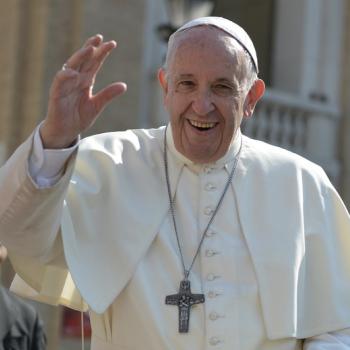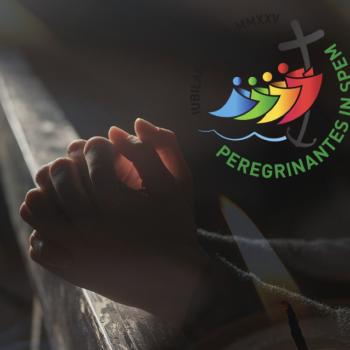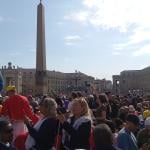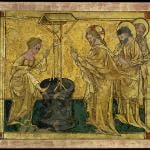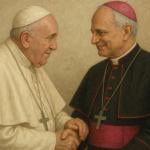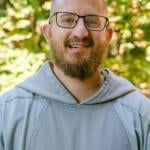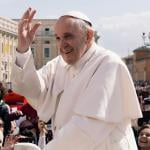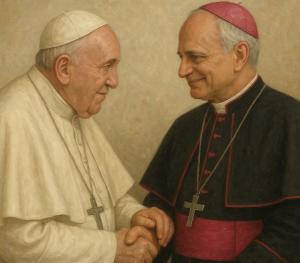
After the death of Pope Francis on April 21, 2025, the cardinals gathered in Conclave to elect the new successor of St. Peter. Locked in the Sistine chapel, it took them 4 scrutinies, that is, four ballots and only two days in conclave, to reach a decision. After two black smoke signals, just after 6 in the afternoon, Rome time, the white smoke emanated from chimney of the Sistine Chapel announcing that the Catholic Church had a pope.
Approximately an hour later, the curtain of the central loggia of St. Peter’s Basilica was opened. The Cardinal Protodeacon, Dominique Mamberti, pronounced the longed-for Habemum Papam, announcing with great joy that it was Robert Cardinal Prevost, who had given himself the name of Leo XIV.
With a serene smile, behind the processional cross, Pope Leo XIV went out to the central balcony and received the warm welcome of the crowd gathered in St. Peter’s Square and beyond, while tears of emotion flowed from the eyes of millions who witnessed the moment from their homes.
Leo XVI offered a greeting of peace, offered his first locution in Italian, as bishop of Rome, quoting Pope Francis and St. Augustine, since the new pope is an Augustinian friar. He allowed himself to break the protocol and sent a greeting in different language. He did it in Spanish, to the diocese of Chiclayo in Perú, where he had been a bishop. He concluded imparting his first blessing Urbi et orbi granting a plenary indulgence.
The Church has welcomed the new Pope with joy and approval. But, who is Robert Prevost?
His infancy
Robert Francis Prevost Martinez was born in Chicago on September 14, 1955 at Mercy Hospital and Medical Center. His father was Louis Marius Prevost, superintendent of education and catechist, son of immigrants. His father from Italy and his mother from France. Rob’s mother (as his family calls him) was Mildred Agnes Martínez, a librarian. His father was most likely born in Santo Domingo. His mother was a Creole from Louisiana of French, African and Spanish descent.
Rob grew up next to his two older brothers, Louis, a former soldier. And John, director of a Catholic school, already retired. His mother died in 1990 and his father in 1997.
He likes to watch baseball and is a fan of the Chicago White Sox. He also plays tennis.
From Math to Canon Law
In 1977 he obtained his bachelor’s degree in Mathematical Sciences at the University of Villanova in Pennsylvania. That same year, being 22 years old, he entered the seminary of the Order of St. Augustine, a mendicant order established in the Middle Ages, in 1243, under the pontificate of Inocent IV with the intention of unifying different communities of hermits that had emerged under the monastic experience of St. Augustine and his Rule of the fourth century.
In 1981, Robert made the profession of his solemn vows and studied at the Catholic Theological Union in Chicago, to obtain his bachelor’s degree in Theology.
In 1982, he was ordained to the priesthood.
The Augustinians sent him as a missionary to Perú between 1985 and 86 to serve in the mission of Chulucanas Piura.
The following year, he obtained his doctorate in Canon Law at the Angelicum, the Pontifical University of St. Thomas in Rome and was appointed direct of vocations and missions of the Augustinian province in the United States.
A missionary in Perú
In 1988 he joined the Trujillo mission in Peru, as director of the common training project for the Augustinian aspirants of the vicariates of Chulucanas, Iquitos and Apurimac.
In 1999, the Augustinians appointed him provincial prior in Chicago.
Two years later, the Order of St. Augustine appointed him its prior general, a position entrusted to him again for a second term, in the general chapter of 2007.
In 2014, Pope Francis appointed him apostolic administrator of the diocese of Chiclayo. A month later, on the feast of Our Lady of Guadalupe, he was ordained bishop in the cathedral of that diocese. He took as his episcopal motto the phrase of St. Augustine In Illo uno, In Him, we are one. That year, his alma mater, the University of Villanova, awarded him an honorary Doctor of Humanities honoris causa.
A Peruvian citizen and bishop
The following year, 2015, he was naturalized Peruvian and at the end of that year, the Holy Father named him bishop of the diocese of Chiclayo.
In 2018, the bishops of Perú appointed him second vice president of their episcopal conference.
In 2019, Pope Francis appointed him to the Congregation for the Clergy, thus beginning to give him direct experience in the Roman curia. The following year, he also commissioned him to collaborate with the Congregation for Bishops.
In 2020, the Pope appointed him apostolic administrator of the diocese of Callao and in 2023, Prefect of the Dicastery for Bishops and also President of the Pontifical Commission for Latin America. That same year, he was also created a cardinal.
Becoming an expert in the Roman curia
Pope Francis appointed Prevost to serve in several more dicasteries, broadening his experience in the curia and thus allowing him to be known by several other cardinals, bishops and officials of these dicasteries: Doctrine of the Faith, for the Evangelization of the Peoples, for the Institutes of Consecrated Life, for Culture and Education, for the Legislative Texts, as well as the Pontifical Commission for the Vatican State.
It seems Pope Francis had set an eye on Robert Prevost, decided to take him under his wing, and paved the road for him to become the next successor of St. Peter —the rest would be up to the cardinals and more importantly, up to the Holy Spirit, if such was God’s will.
Becoming the Vicar of Christ
Looking at his background, his formation, his missionary experience in Latin America, and his extensive work with the Roman Curia, it is not surprising that more than 100 cardinals in the conclave voted for Prevost. With the aid of the Holy Spirit, Prevost seemed to the cardinals the right one to continue the work initiated by Pope Francis and the one needed to build bridges of unification inside and outside the Church.
Robert Francis Cardinal Prevost Martinez accepted the election and took the name of Leo XIV. White smoke came out of the chimney at the rooftop of the Sistine Chapel…
A new Leo for a new revolution
The Roman Pontiff has explained that he chose the name of Leo XIV after Leo XIII, who was the pope during the Industrial Revolution, a time of great progress that at the same time implied great social and economic challenges to which the pope responded with the Catholic Social Doctrine, reflected in his famous encyclical Rerum Novarum (Of the New Things) in 1891.
Leo XIII considers that our time is going through a digital revolution in which artificial intelligence will also bring great progress, but will imply significant social, economic and labor challenges that deserve a rereading of the Catholic Social Doctrine to serve as a moral compass.
A pope of peace
It is clear that Leo XIV’s top priority is world peace. His first words when he introduced himself before giving his blessing Urbi et orbi, was in greeting of peace: “Peace be with you all!”
Hence, he has emphasized his desire to work for peace, seeking the collaboration of the Catholic faithful, cardinals, journalists, diplomats and all men of good will.
“For my part, I will make every effort so that this peace may prevail. The Holy See is always ready to help bring enemies together, face to face, to talk to one another, so that peoples everywhere may once more find hope and recover the dignity they deserve, the dignity of peace. The peoples of our world desire peace, and to their leaders I appeal with all my heart: Let us meet, let us talk, let us negotiate! War is never inevitable.”
(Address to participants in the Jubilee of Oriental Churches, May 14, 2025).
Peace is the theme that he has most recurrently touched on in the first days of his pontificate and undoubtedly the main reason for his pastoral work in the times to come.
Robert Francis Cardinal Prevost Martinez, an Augustinian friar, a Peruvian born in Chicago, who carried on his pectoral cross a relic of St. Augustine and another of his mother, Santa Monica. Today he is our Pope Leo XIV, High Pontiff of the Catholic Church, Bishop of Rome, Successor of St. Peter and the 267th Vicar of Christ on Earth.


